IFFO’s Members’ Meeting, held in Madrid on the 13th and 14th May 2025, was open by the IFFO President Egil Magne Haugstad, who welcomed the record 267 delegates from 36 countries. When providing an overview of IFFO’s growth in the last year, he noted that both the group’s membership and breadth of work continues to increase. He touched on the complexities facing the marine ingredients industry with the uncertain global markets and called for a regulated and stable trade system to encourage the best value creation for marine ingredients globally.
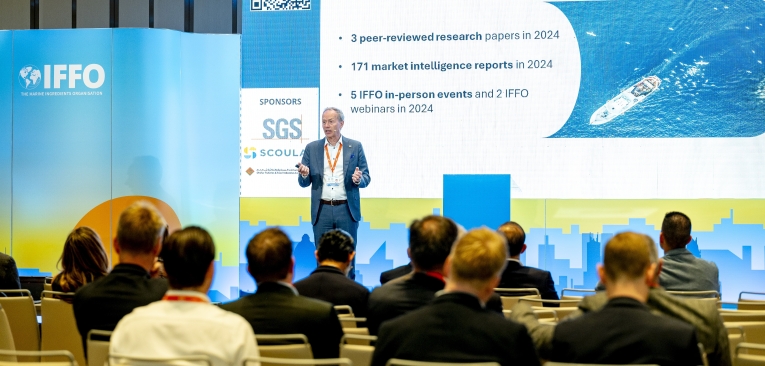
Nutrition for the future
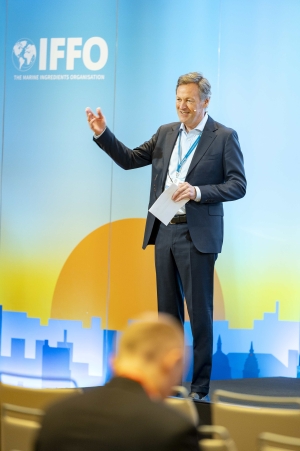 IFFO’s Director General Petter Martin Johannessen presented an overview of IFFO’s work, highlighted the science and fact-based approach, with peer-reviewed papers and leading the development of the future metrics for sustainable feed ingredients. He noted that “marine Ingredients will continue to be the nutritional platform for modern and industrial aquaculture for the foreseeable future. Essential amino acids, vitamins, minerals and omega-3 all contribute to human health through healthy seafood. Aquaculture brings these essential nutrients to people and contributes to healthier food, not just more food!”
IFFO’s Director General Petter Martin Johannessen presented an overview of IFFO’s work, highlighted the science and fact-based approach, with peer-reviewed papers and leading the development of the future metrics for sustainable feed ingredients. He noted that “marine Ingredients will continue to be the nutritional platform for modern and industrial aquaculture for the foreseeable future. Essential amino acids, vitamins, minerals and omega-3 all contribute to human health through healthy seafood. Aquaculture brings these essential nutrients to people and contributes to healthier food, not just more food!”
Impacts of tariffs
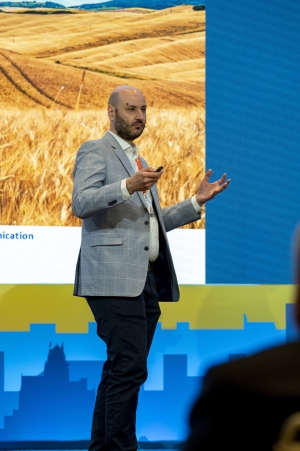 Starting with a global perspective, Rabobank’s Head of Agri Commodities Market Research, Carlos Mera, presented an overview of major trends in the agricultural commodities. Mera opened with a focus on the impacts of US trade tariffs, which are affecting many food products. “Prices of agricultural commodities have been increasingly stable over the last weeks. The US dollar has weakened, which should support prices” he noted.
Starting with a global perspective, Rabobank’s Head of Agri Commodities Market Research, Carlos Mera, presented an overview of major trends in the agricultural commodities. Mera opened with a focus on the impacts of US trade tariffs, which are affecting many food products. “Prices of agricultural commodities have been increasingly stable over the last weeks. The US dollar has weakened, which should support prices” he noted.
As happened in 2018 during the trade war, China is expected to shift purchases to South America, with the emergence of Brazil as a dominant soy exporter. 60% of global soybean production is going to China, although China’s soy imports are cooling: next year, Brazil is expected to export more soybean than China will import. Recent global trade tariffs, most notably between the US, China, and also Canada have caused a depression in agricultural prices, with the wheat market being more sensitive to shocks. The US is expected to increase its use of vegetable oils as fuel, with prices likely to increase and show volatility.
Insects and EU regulations
Focusing on an additional feed ingredient, that of insects, Steven Barbosa, Deputy Secretary General of the International Platform of Insects for Food and Feed (IPIFF), provided a market and regulatory update from the sector. Barbosa noted that the on-going aim of member organisation IPIFF was to support the authorisation of new feeding substrates for farmed insects and permit the EU commercialisation of insect frass (larvae faeces). Since July 2017, insects are authorised in aquafeeds within the EU. Aquafeed containing insect-derived ingredients is used mostly in the feed for salmon, trout, seabream or seabass.
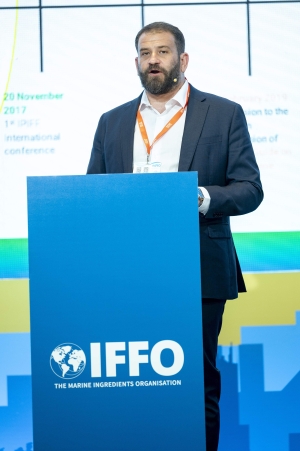 Barbosa stated that “IPIFF presents insect proteins as a great complement to fishmeal and soybean meal, with relatively small inclusion rates needed to achieve their functional properties. As such, their price will not be a reflection of what they replace but what they contribute to the overall value proposition of the feed. By 2030, we estimate a global market potential of up to 200,000 metric tons, or 40% of the insect protein market and representing less than roughly 1% of the global aquafeed market in today’s volumes.” Regarding regulatory challenges, he noted that bottlenecks, including legal standards, are often restricting circularity (e.g., prohibitions on the use of certain products as feed), blocking the possible use in feed of nutrients recovered from waste streams (currently prohibited): “One of the main regulatory constraints we have is the authorised substrates in feeding insects , which means that according to EU legislation, insects may only be fed with organic former foodstuffs, which means they cannot contain residues of fish and meat. This is not the case in other parts of the world”. Concluding his presentation, he highlighted the need for collaboration: “The insect sector cannot exist in aquafeed without working with the fishmeal and fish oil sector”.
Barbosa stated that “IPIFF presents insect proteins as a great complement to fishmeal and soybean meal, with relatively small inclusion rates needed to achieve their functional properties. As such, their price will not be a reflection of what they replace but what they contribute to the overall value proposition of the feed. By 2030, we estimate a global market potential of up to 200,000 metric tons, or 40% of the insect protein market and representing less than roughly 1% of the global aquafeed market in today’s volumes.” Regarding regulatory challenges, he noted that bottlenecks, including legal standards, are often restricting circularity (e.g., prohibitions on the use of certain products as feed), blocking the possible use in feed of nutrients recovered from waste streams (currently prohibited): “One of the main regulatory constraints we have is the authorised substrates in feeding insects , which means that according to EU legislation, insects may only be fed with organic former foodstuffs, which means they cannot contain residues of fish and meat. This is not the case in other parts of the world”. Concluding his presentation, he highlighted the need for collaboration: “The insect sector cannot exist in aquafeed without working with the fishmeal and fish oil sector”.
Microplastics and fish physiology
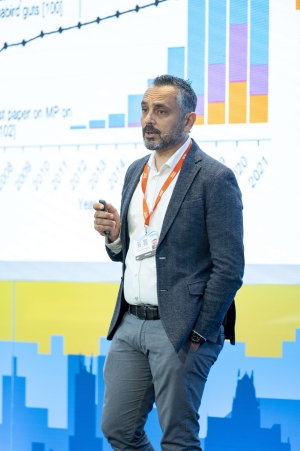 Presenting his latest study on microplastics, Tufan Eroldogan from the University of Cukurova and founder of Aquaspin, said that this was the first globally comprehensive study on plastic contamination of fishmeal. Microplastics refer to manufactured polymers ranging in size from 1 μm to 5 mm that are water-insoluble, and it is estimated that 4.8–12.7 million tons of plastic waste reach the oceans each year. The sampling consisted of 26 different fishmeal products, originating from 11 countries on four continents and Antarctica, and representing the vast majority of globally available and traded commercial products. He noted that plastic content of fishmeal also appears to be regionally dependent, which is likely due to the plastic contamination level in the marine environment, and that microplastic contamination might occur in virtually all ingredients. Eroldogan called for more data and targeted research to assess the impacts of plastic (micro- and/or nano-plastic) on different aquaculture animals and assess human and local environment exposure risks from these practices.
Presenting his latest study on microplastics, Tufan Eroldogan from the University of Cukurova and founder of Aquaspin, said that this was the first globally comprehensive study on plastic contamination of fishmeal. Microplastics refer to manufactured polymers ranging in size from 1 μm to 5 mm that are water-insoluble, and it is estimated that 4.8–12.7 million tons of plastic waste reach the oceans each year. The sampling consisted of 26 different fishmeal products, originating from 11 countries on four continents and Antarctica, and representing the vast majority of globally available and traded commercial products. He noted that plastic content of fishmeal also appears to be regionally dependent, which is likely due to the plastic contamination level in the marine environment, and that microplastic contamination might occur in virtually all ingredients. Eroldogan called for more data and targeted research to assess the impacts of plastic (micro- and/or nano-plastic) on different aquaculture animals and assess human and local environment exposure risks from these practices.
Making sense of International Maritime Organisation (IMO) regulations
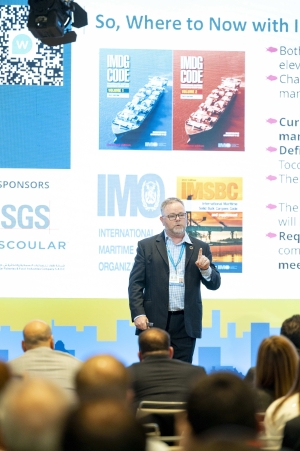 Ending this first session, IFFO’s Technical Director, Brett Glencross, presented an overview of IMO Regulations and the impacts on the marine ingredients sector. The IMO or International Maritime Organisation is the United Nations specialised agency with responsibility for the safety and security of shipping and the prevention of marine and atmospheric pollution by shipping. Glencross noted that according to the “Cargo Integrity Group” of the International Cargo Handling Coordination Association (ICHCA), fishmeal has been identified as one of the fifteen “cargoes of concern”, six of which pose a threat when it comes to container fires. He presented how fishmeal stability is assessed, with self-heating tests and the rules around the use of antioxidants.
Ending this first session, IFFO’s Technical Director, Brett Glencross, presented an overview of IMO Regulations and the impacts on the marine ingredients sector. The IMO or International Maritime Organisation is the United Nations specialised agency with responsibility for the safety and security of shipping and the prevention of marine and atmospheric pollution by shipping. Glencross noted that according to the “Cargo Integrity Group” of the International Cargo Handling Coordination Association (ICHCA), fishmeal has been identified as one of the fifteen “cargoes of concern”, six of which pose a threat when it comes to container fires. He presented how fishmeal stability is assessed, with self-heating tests and the rules around the use of antioxidants.
In summary, Glencross noted that IMO Shipping Regulations now have partial alignment of IMSBC and IMDG as MHB(SH) with 250ppm Tocopherols, mandatory from 1st January 2025 (voluntary from 1st January 2024). There is now full alignment of the IMSBC and IMDG codes (except ethoxyquin levels) from 1st January 2026. Lastly, the new Group-C non-dangerous goods schedule will be available from 1st January 2026. Glencross concluded with an overview of IFFO’s technical projects, notably the updating of the GFLI Database (Global Feed Lifecycle Assessment Institute).
The event continues on the 14th May, focusing on demand for marine ingredients.








